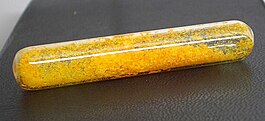Tetrachloroauric acid
 |
|
| Names | |
|---|---|
| Other names
Hydrogen tetrachloroaurate,
Chlorauric acid, Aurochloric acid, Aurate(1−), tetrachloro-, hydrogen, (SP-4-1)-, Hydrogen aurichloride |
|
| Identifiers | |
|
|
|
3D model (JSmol)
|
|
| ChemSpider | |
| ECHA InfoCard | 100.037.211 |
|
PubChem CID
|
|
|
|
|
|
| Properties | |
| HAuCl4 | |
| Molar mass | 339.785 g/mol (anhydrous) 393.833 g/mol (trihydrate) 411.85 g/mol (tetrahydrate) |
| Appearance | orange-yellow needle-like crystals hygroscopic |
| Density | 3.9 g/cm3 (anhydrous) 2.89 g/cm3 (tetrahydrate) |
| Melting point | 254 °C (489 °F; 527 K) (decomposes) |
| 350 g HAuCl4 / 100 g H2O | |
| Solubility | soluble in alcohol, ester, ether, ketone |
| Structure | |
| monoclinic | |
| Hazards | |
| Safety data sheet | JT Baker |
|
EU classification (DSD) (outdated)
|
not listed |
| NFPA 704 | |
| Related compounds | |
|
Other anions
|
Tetrabromoauric acid |
|
Except where otherwise noted, data are given for materials in their standard state (at 25 °C [77 °F], 100 kPa).
|
|
|
|
|
| Infobox references | |
Chloroauric acid is an inorganic compound with the chemical formula HAuCl
4. Both the trihydrate and tetrahydrate are known. It is an orange-yellow solid, a common precursor to other gold compounds and an intermediate in the purification of gold metal. Both the trihydrate and tetrahydrate are available commercially.
Chloroauric acid is a strong monoprotic acid.
The crystalline tetrahydrate is known to contain H
5O+
2·AuCl−
4 and two water molecules. The AuCl−
4 anion has square planar molecular geometry. The Au–Cl distances are around 2.28 Å. Other d8 complexes adopt similar structures, e.g. [PtCl4]2−.
Solid chloroauric acid is a hydrophilic (ionic) protic solute. It is soluble not only in water, but also in many oxygen-containing solvents, such as alcohols, esters, ethers, and ketones. For example, in dry dibutyl ether of diethylene glycol, the solubility exceeds 1 mol/L. Saturated solutions in the organic solvents often are the liquid solvates of specific stoichiometry.
When heated in air, solid HAuCl4·nH2O melts in the water of crystallization, quickly darkens and becomes dark brown.
Upon treating chloroauric acid with a standard base, it converts to metal, tetrachloridoaurate and water. The related thallium salt is poorly soluble in all nonreacting solvents. Salts of quaternary ammonium cations are known. Other complex salts include [Au(bipy)Cl2][AuCl4] and [Co(NH3)6][AuCl4]Cl2.
...
Wikipedia

